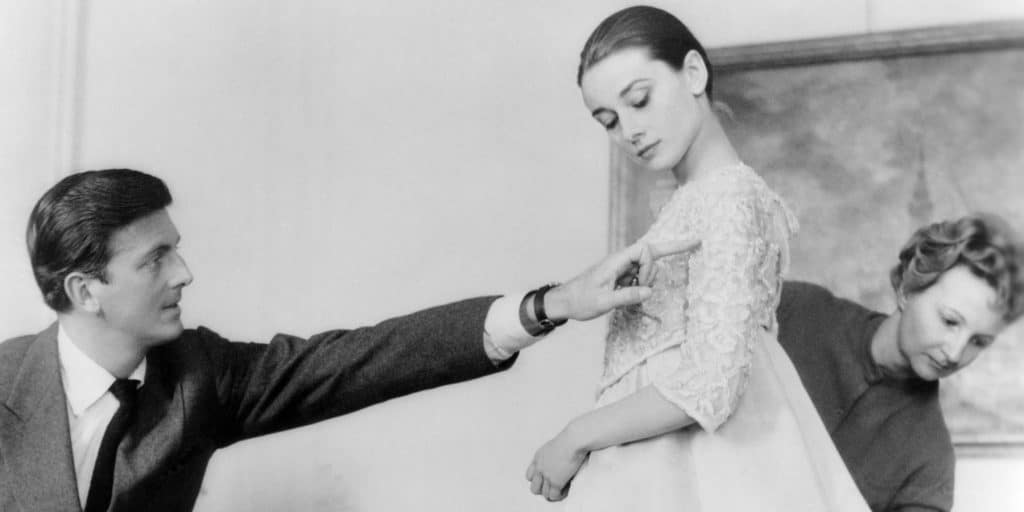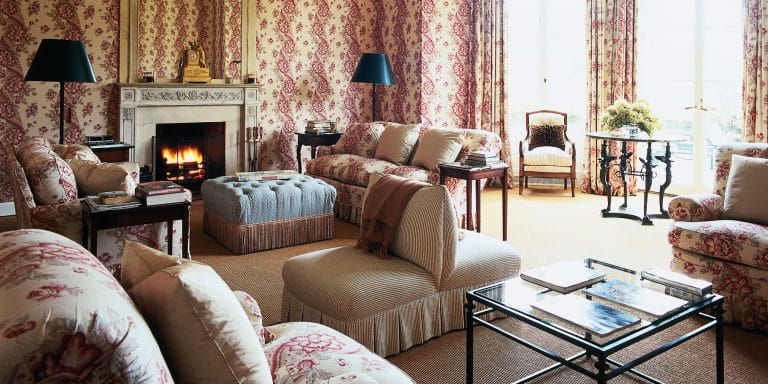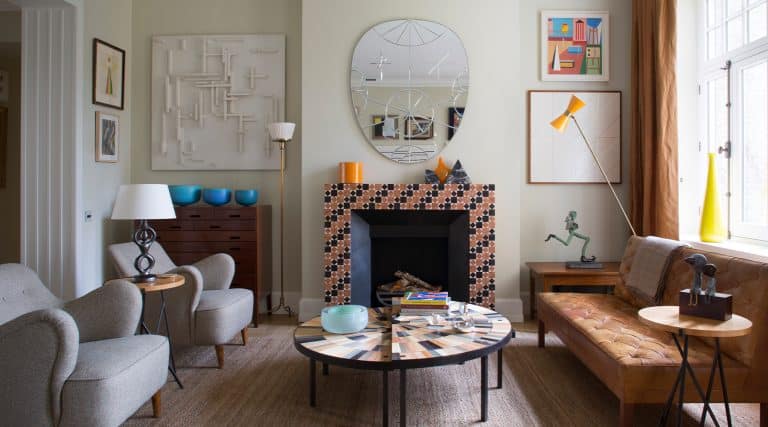
April 22, 2018Hubert de Givenchy, who founded his eponymous French fashion house in 1952, died last month at the age of 91. This photograph, taken by his good friend, the legendary Chicago-based lensman Victor Skrebneski, in 1975, was long the designer’s favorite portrait (photograph © Skrebneski). Top: His career is practically synonymous with that of Audrey Hepburn, whom he dressed from the mid-1950s until her death, in 1993 (photo by Sunset Boulevard/Corbis via Getty Images).
Few designers influenced women’s fashion in the middle of the 20th century quite as remarkably as Hubert de Givenchy. But then few designers dressed one of the period’s premiere fashion icons quite the way Givenchy did.
As the man who created looks for Audrey Hepburn both off screen and on — in movies including Sabrina (that embroidered white organdy gown), Funny Face (that black turtleneck, cigarette pants and ballet flats combo) and Breakfast at Tiffany’s (that quintessential little black dress) — Givenchy ushered in an era of simplicity and easy style. And thanks to Hepburn’s popularity and the success of her films, the world took notice of this aristocratic Frenchman and his handiwork.
When Givenchy died last month at the age of 91, we lost one of the last — if not the last — of the aesthetic arbiters who redefined Continental couture in the years following World War II. Educated at Paris’s École des Beaux-Arts, he worked for Jacques Fath, Robert Piguet, Lucien Lelong and Elsa Schiaparelli before launching his own label in 1952. Two years later, he became the first designer to present a luxury prêt-à-porter collection. Shortly thereafter, he met Hepburn. Spoken of now in the same breath as Christian Dior and Pierre Balmain, he is known as much for his column sheath dresses and his chic American-sportswear-influenced separates as for those little black dresses.

Givenchy designed this evening ensemble, comprised of a satin dress and cashmere coat, for his winter 1991 collection. It featured prominently in a 2017 retrospective of the designer’s work at the Museum of Lace and Fashion, in Calais, France. Photograph © Skrebneski
Givenchy was fond of quoting — and following — early advice he received from his mentor, the Spanish designer Cristóbal Balenciaga, proclaiming, somewhat iconoclastically in the early 1950s, that “the dress must follow the body of a woman, not the body following the shape of the dress.” He also made the even more outré statement that “all a woman needs to be chic is a raincoat, two suits, a pair of trousers and a cashmere sweater.” That maxim might not have been the best for business, were it not for the fact that his gowns and other finery were so incredibly beautiful. Beyond Hepburn, the legendary mid-century client-muses to whom he provided dresses included Bunny Mellon, the Duchess of Windsor, Jacqueline Kennedy, Deeda Blair, Elizabeth Taylor, Grace Kelly and more. The list, as they say, goes on and on.
His aesthetic influence, however, was not limited to fashion. The gardens and interiors of his homes — including apartments in an 18th-century hôtel particulier in Paris and Manoir du Jonchet, a 16th-century Renaissance-style château in the French countryside — featured an indelible mix of the finest antiques and art. At the manoir, for example, a Joan Miró painting hung beneath a Diego Giacometti fixture on a stair landing; a Compagnie des Indes porcelain service sat atop the table in a dining room whose walls were covered with an 18th-century chinoiserie paper; a bronze deer by François Pompon stood guard near a fireplace; and Louis XV pieces, toile de Jouy and Barovier & Toso Venetian glassware abounded. A 1993 Christie’s sale of items from his collection fetched more than $26 million (upwards of $45 million in today’s dollars), and the same auction house’s March 2017 sale of his Giacometti furnishings alone brought in more than $34.5 million.
Today, vintage Givenchy fashions look as au courant as they did at the time of their creation. That was very much by design. As he told the Washington Post in 1982 — on the eve of the debut of a 30th-anniversary retrospective of his work at New York’s Fashion Institute of Technology, six years before he sold his label to LVMH and 13 before he retired — “It is unjust to wear clothes just for one season or two. You must cherish your clothes.”
Here, seven Givenchy aficionados reveal why they so admired this masterful man. — Andrew Sessa

Audrey Hepburn on the set of 1961’s Breakfast at Tiffany’s in Givenchy’s little black dress, which is as memorable as the film itself. Photo by Paramount Pictures/Sunset Boulevard/Corbis via Getty Images
Valerie Steele
Director and chief curator of the Museum at the Fashion Institute of Technology, in New York
I never actually met Givenchy, but I think that he had a tremendous impact in a couple of areas. First, of course, was his collaboration with Audrey Hepburn, which created iconic fashion images, particularly that of the little black dress in Breakfast at Tiffany’s. More generally, their pairing, with her functioning so beautifully as his muse, has had a continuous impact not just on fashion but on our idea of female beauty.
Givenchy’s second area of impact was as a younger member of the postwar generation of designers in France. First, there were Dior and Balenciaga, but then he — along with Fath and Balmain — helped resuscitate couture after World War II had almost obliterated it. That, in turn, brought French fashion back to life and back to a very important position.
I would also add that, in his retirement, he made it a point to support the historical memory of mid-century fashion, particular through his support of the Balenciaga museum, in Spain and the way he helped curate shows.
His look was one of younger, refined French femininity, a somewhat more streamlined but also more elegant aesthetic — not as theatrical as that of Dior or Fath but instead something that moved to a more youthful feeling. That look is a part of why he was able to help revive French fashion. We associate the younger look with someone like Yves Saint Laurent, but Givenchy was very pivotal in this, especially with his work with Hepburn, which made clothes more simple, offering a new idea of feminine beauty.

Pamela Fiori
Former editor in chief of Town & Country and Travel + Leisure
The first time I laid eyes on Hubert de Givenchy, all six feet, five inches of him, he was wearing a bathing suit. This was in the late 1980s, at the pool of the Hotel Cipriani, in Venice. He walked slowly around its perimeter with the graceful gait of a gazelle at a watering hole. It was a memorable sighting. What little I knew about him — I was editor of Travel & Leisure magazine at the time; not much fashion coverage there — was connected to his muse and close friend, Audrey Hepburn.
The story goes that Hepburn made an appointment with Givenchy at his Paris atelier when she was looking for clothes to wear in the 1954 romantic comedy Sabrina. He mistakenly thought that the Hepburn who was coming was Katharine. Instead it was a slim, broad-shouldered beauty who seemed born to wear his designs. From that moment on, they forged a friendship and collaboration that lasted her lifetime (she died in 1993).
In almost every movie from then on, he was her costumier, including for Charade, How to Steal a Million, Funny Face and Breakfast at Tiffany’s. (Who could ever forget the opening scene, with Hepburn as Holly Golightly staring longingly at the window of Tiffany’s in that now-legendary little black dress?)
I met Hubert in the fall of 1993, when he designed a one-off collection in memory of Hepburn for Barneys in New York. By this time, I was editor of Town & Country. We featured the collection on our pages, and I wrote the first of what were to be many articles about the actress. Hubert and I cohosted a cocktail party at the store. As is true of many extremely tall men, he was rather shy but ever so gallant. We met several times after that, sometimes after his fashion shows and never for very long. He retired in 1995. The house of Givenchy was not the same without his elegant touch. Nor, for that matter, was fashion.

Floor-to-ceiling drapes frame the garden view from Givenchy’s Green Salon in an 18th-century Parisian hôtel particulier. Photo © Francis Hammond
Alexa Hampton
Interior designer and owner and president of Mark Hampton
As a young girl, I was steeped in the talent of Givenchy, because mine was a family of film buffs, and I absolutely loved the clothes Audrey Hepburn wore in movies like Love in the Afternoon, Sabrina, Funny Face and Charade. Consequently, he loomed large in my imagination.
Then, the year after I graduated from Brown, while I was working for my father back home in New York, the Givenchy auction hit the city. At the time, Christie’s hadn’t yet moved to its current home and was just a short block from our office. I haunted that sale, and it made an enormous impression on me.
His use of boulle, especially, was masterful. Such dense, dark pieces are particularly tricky to place, and, in his hands, they were flawlessly deployed.
All the pieces were so pitch-perfect — both on their own and combined with one another. I loved the unabashed grandeur of his style and how everything screamed high fashion. I was galvanized and mesmerized. Ever since, I have regarded his as the apotheosis of great taste.

Givenchy first dressed Hepburn for Billy Wilder’s 1954 classic film Sabrina, creating, among other pieces, a white organdy gown for a ball scene — shown here in a Mark Shaw photograph available on 1stdibs through Liz O’Brien.
Tony Tiemeyer
Vintage fashion dealer and owner of Evolution, in Cincinnati, Ohio
Givenchy was a quiet rebel. He disregarded his aristocratic family’s distaste for work, instead dedicating himself to a craft measured by effort and obsession.
By now, the lore of Givenchy’s relationship with Audrey Hepburn has made the rounds, but I can’t separate the two in my mind. How he thought he was meeting Katharine. How she insisted on working with the relatively green couturier. Audrey, his graceful muse. Hubert, the man who clad her in unimaginably chic armor, using lush fabrics and a signature eye for detail to shield her from Hollywood’s crushing expectations.
William Banks-Blaney
Vintage fashion dealer, founder and owner of London’s WilliamVintage

Pieces designed by Givenchy currently on offer through William Banks-Blaney’s vintage fashion gallery, WilliamVintage, include, from left, an haute couture floral silk dress, ca. 1988; a red organza skirt with matching scarf tie belt, ca. 1968; and an haute couture pink and ivory gown, ca. 1963.
Givenchy was an inspiration in far more fields than fashion. The effortlessly chic, impossibly handsome aristocrat, famed for his geniality, had supreme taste. Givenchy’s couture may have defined femininity for the 20th century, but his homes defined elegance, and his own wardrobe defined the modern man. In a century of trends, fads and ephemeral celebrity, Hubert de Givenchy was about living life your own way and doing it without any contrivance.

Interior designer Timothy Corrigan calls the Green Salon in Givenchy’s Paris home “a room to dream about.” Photo © Francis Hammond
Timothy Corrigan
Interior designer based in Los Angeles and Paris and author of An Invitation to Château du Grand-Lucé: Decorating a Great French Country House
Several months ago at a dinner party, someone asked me to name the most beautiful room I had ever been in. Without a moment’s hesitation, my immediate response was the grand salon of Hubert de Givenchy’s glorious hôtel particular on the Rue de Grenelle, on Paris’s Left Bank.
Everything about M. de Givenchy was the epitome of understated elegance — down to his tiny chauffeur-driven mini-Mercedes with custom leather interior. He was an undisputed master of couture, but I admired him more for his ability to turn even the grandest space into a comfortable, multilayered cocoon that simultaneously soothed and stimulated your senses.
I have often thought about what exactly made that salon so special: luxurious dark-green silk velvet covering comfy down-filled chairs, piles of books scattered throughout, a mix of objets reflecting his many varied interests and the most wonderful unlined silk-taffeta curtains that hung at the sides of the long French doors overlooking the gardens. In short, it was a room to dream about!
M. de Givenchy was one of the last of the true gentleman artists of our day. His passing, just like a blown-out candle in one of the many beautiful hurricane lanterns that filled his rooms, means that his beacon of elegance no longer brightens our world.

This numbered chocolate-brown feathered-chiffon couture gown from the 1960s is among the most prized Givenchy pieces that Brent Edward owner Brent Amerman has come cross.
Brent Amerman
Vintage fashion dealer and owner of Brent Edward, in San Francisco
Hubert de Givenchy had a love and intense passion for all things pretty to the eye. He used this passion to create glamorous dresses and gowns, lush gardens and exquisite homes.
This fashion pioneer designed what is hands down the perfect little black dress, for Audrey Hepburn in Breakfast at Tiffany’s, and it remains among the most iconic dresses of all time. His knowledge about the body of a woman was key. He didn’t embellish with shiny sequins, beads and embroidery, as most designers of the 1960s did. Instead, he was relentless when it came to his focus on fit, which made women feel both confident and feminine. His lines were immaculate and dedicated to flattering the body.
I have sold many vintage Givenchy pieces on 1stdibs, but there are four that nearly brought me to tears when I first saw them: a 1980s black silk-taffeta, long balloon-sleeved haute couture mini dress; a brown pinstripe sleeveless, belted suit-style romper; a numbered chocolate-brown feathered-chiffon couture gown from the 1960s; and a black wool haute couture romper. The first two have sold — those were extremely hard days when I had to let them go. The other two, I finally listed on 1stdibs in the past weeks, as I felt they should go to a new owner who would wear them to represent the late, great Givenchy.
Susan Gutfreund
Interior decorator and a friend, client and former Paris neighbor of Givenchy

In 2017, the Financial Times interviewed and photographed Givenchy at home in his château, surrounded by many of his most prized possessions, not least a bronze Diego Giacometti table, as well as stools and a large candleholder by the Italian creator. Photo by Dylan Thomas
Thanks to his extraordinary connoisseurship, his unerring palette and his distinctive understanding of architectural proportion, Hubert never failed to conjure up a sense of effortless elegance when selecting and arranging all manner of furnishings, whether in his 18th-century hôtel particulier on the rue de Grenelle, in Paris, or his country house, Manoir du Jonchet, outside the city. For me, just being with him was a master class in style and restraint.
His personal aesthetic edict was “edit, edit, edit,” so there were never umpteen Sèvres cachepots or only Régence commodes or merely marquetry in the style of André-Charles Boulle, much less onerous gilt Louis XIV chaises, overwhelming a room. Instead, there was always a mix of periods, and above all, he eschewed the lavish and the predictable.
Whether strolling through a local market or a favorite Paris gallery, he would find the perfect example of a certain period or type of item — a piece of Chantilly porcelain, say. And he would ever so frequently inject one or two totally unexpected elements into a tableau. He once graced a dining room table with orchids in simple terracotta pots, setting them amid early crystal goblets, superb silver and white porcelain edged in gold — unforgettable.
In his country house, one sitting room was filled with Diego Giacometti bronze designs, including a massive octagonal table and a number of taborets, but they never overpowered. And who else ever had such panache when trimming chairs and sofas with cotton slipcovers? Only a couturier of his rare talent knew how to fit them to perfection. His death is a true loss.
Shop Givenchy on 1stdibs


